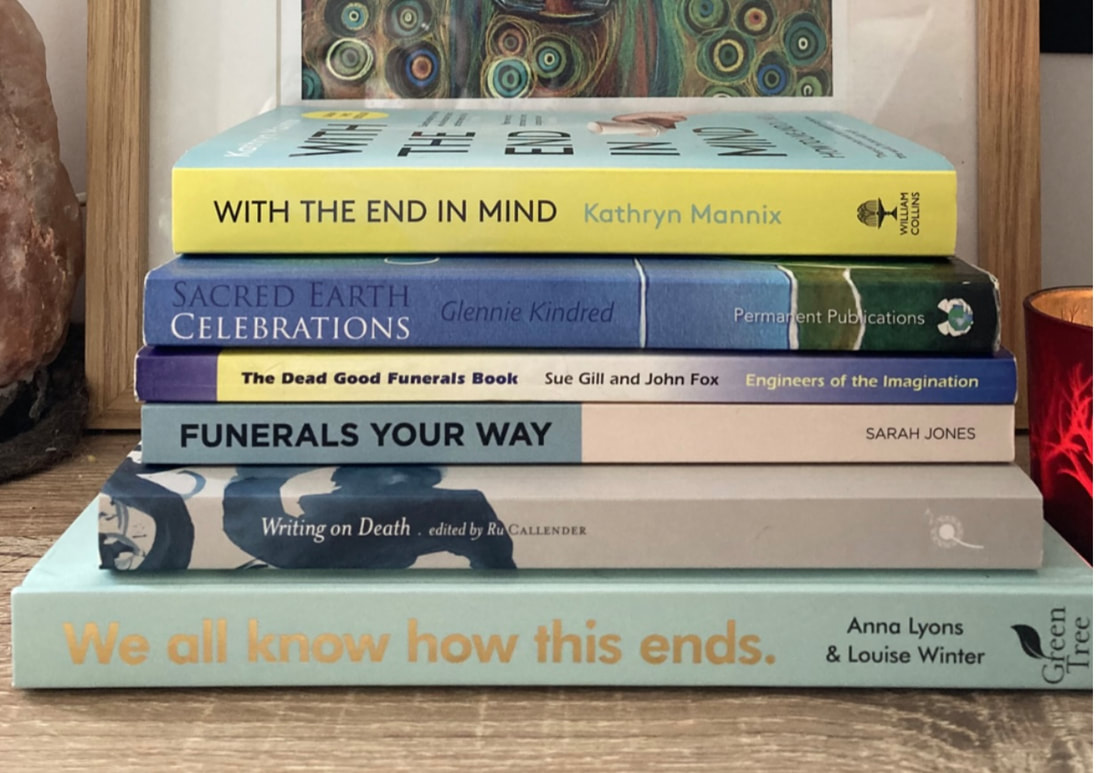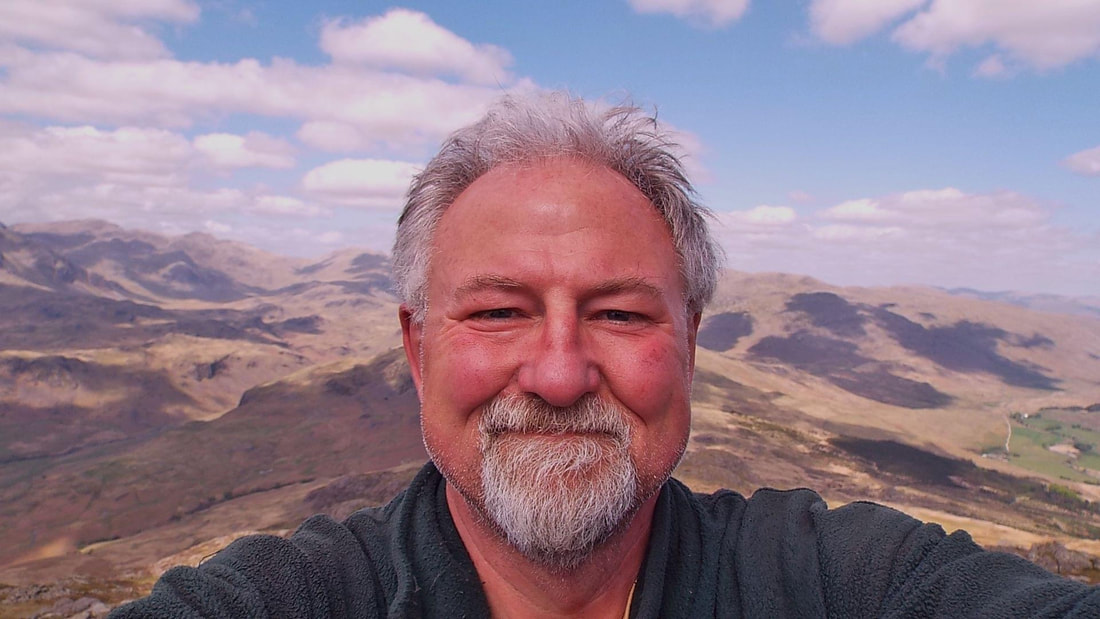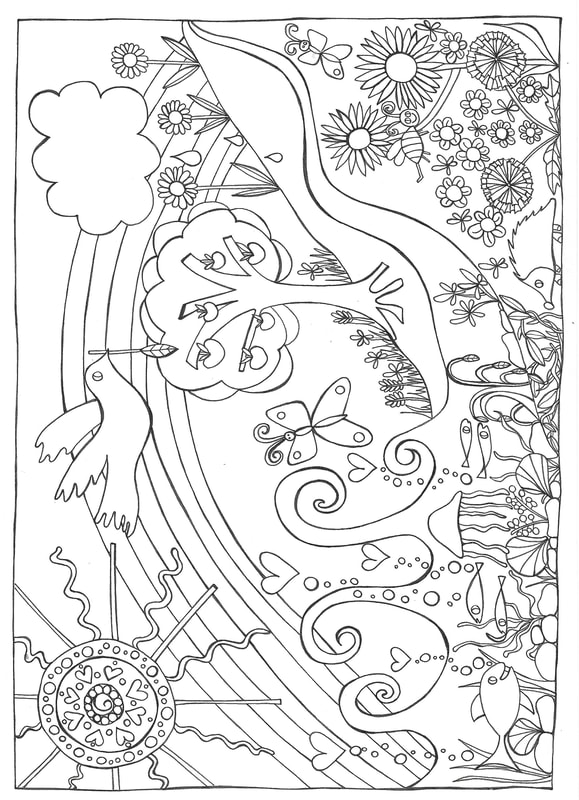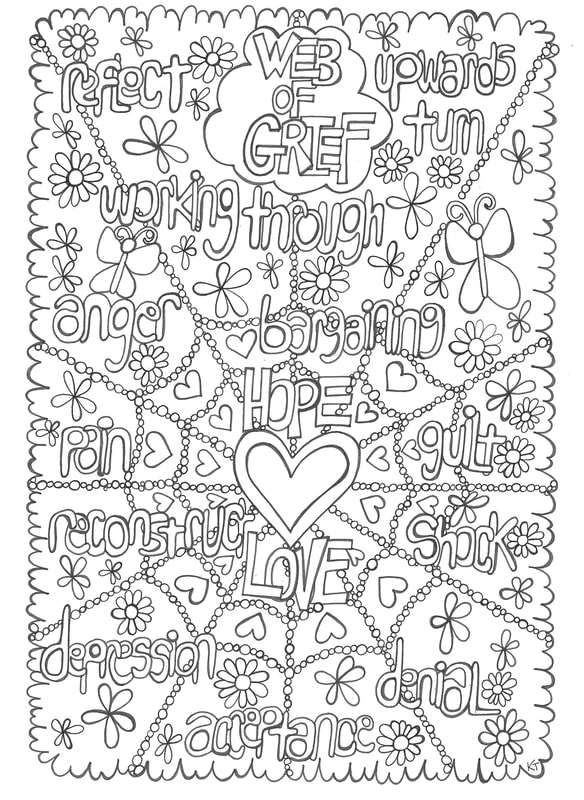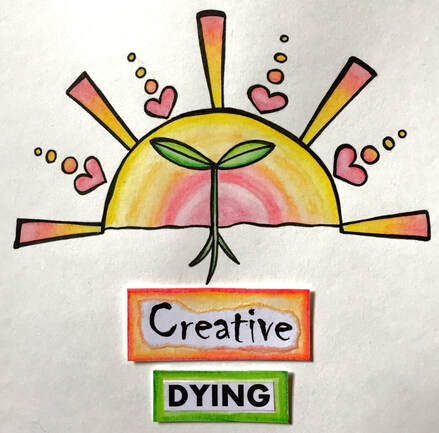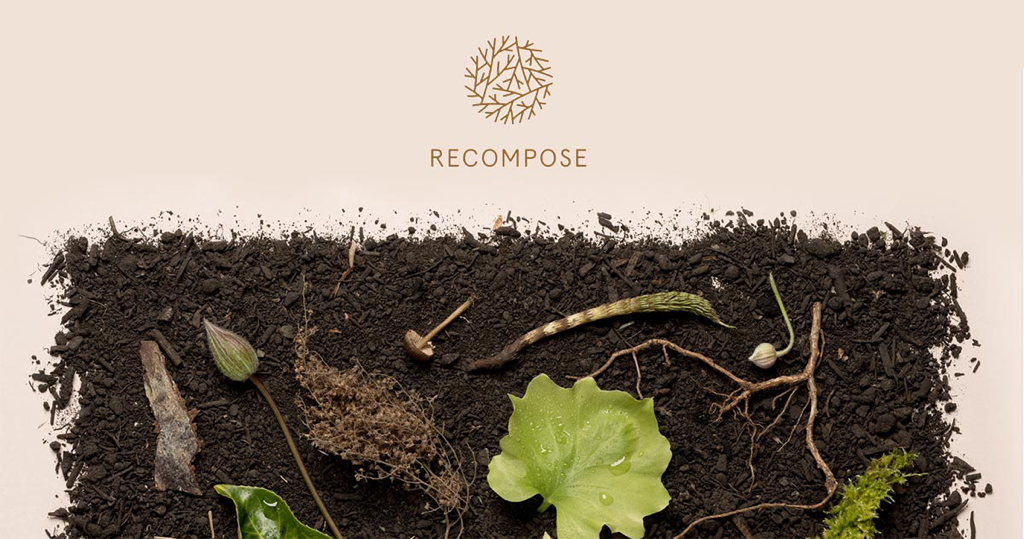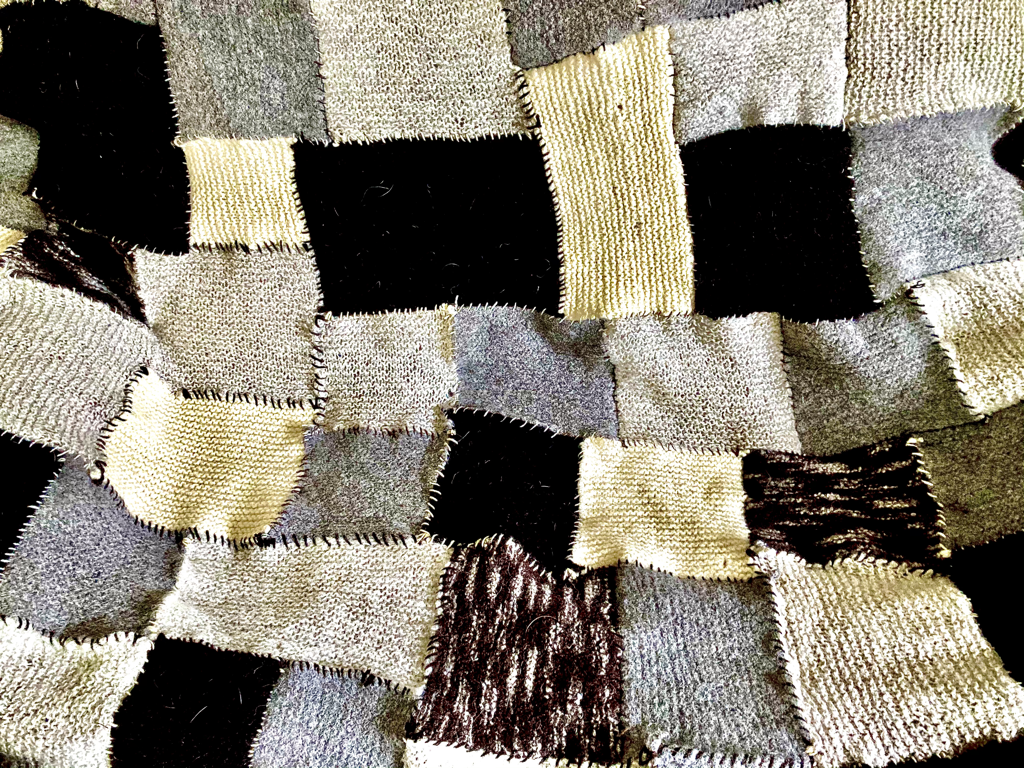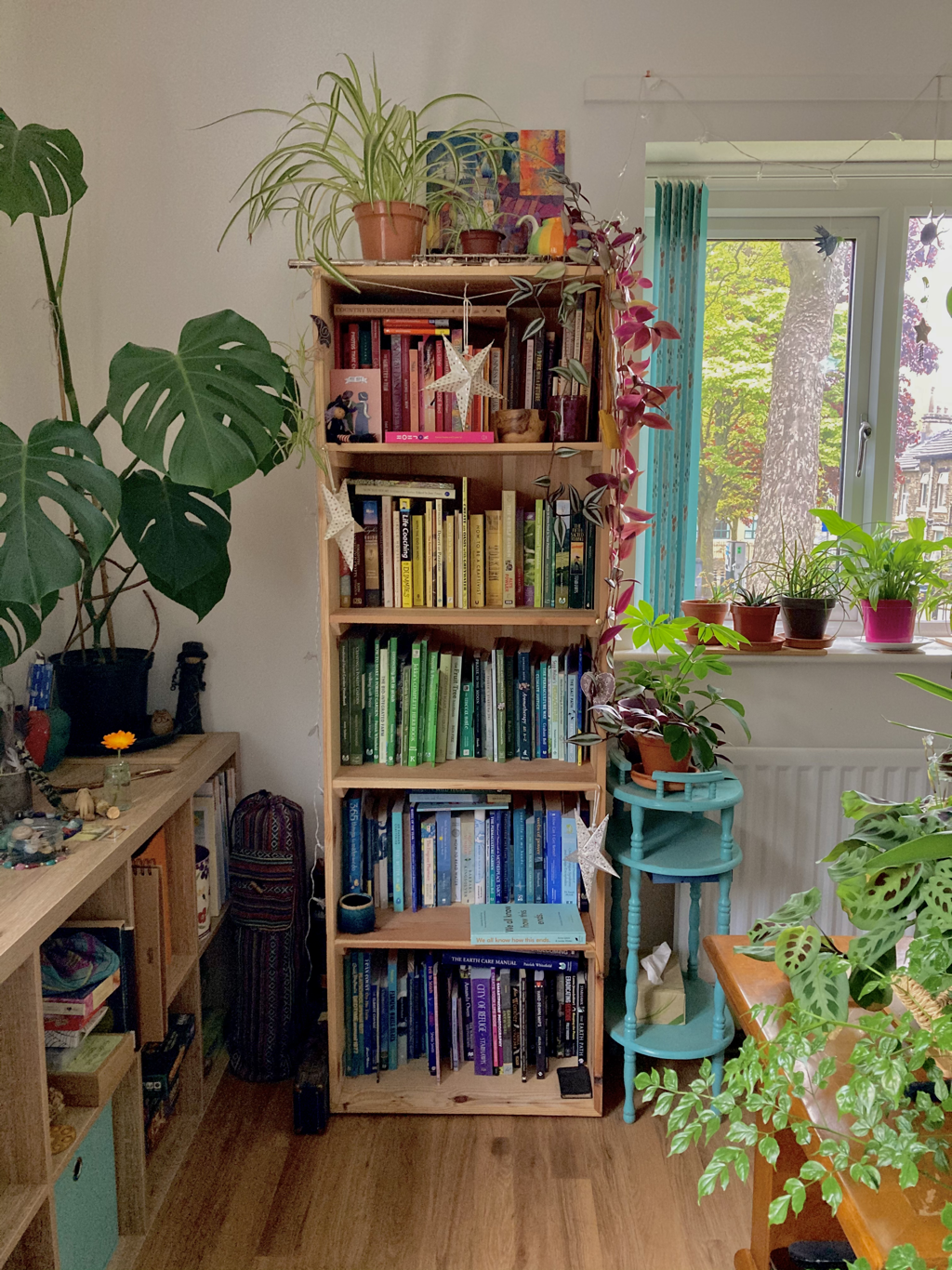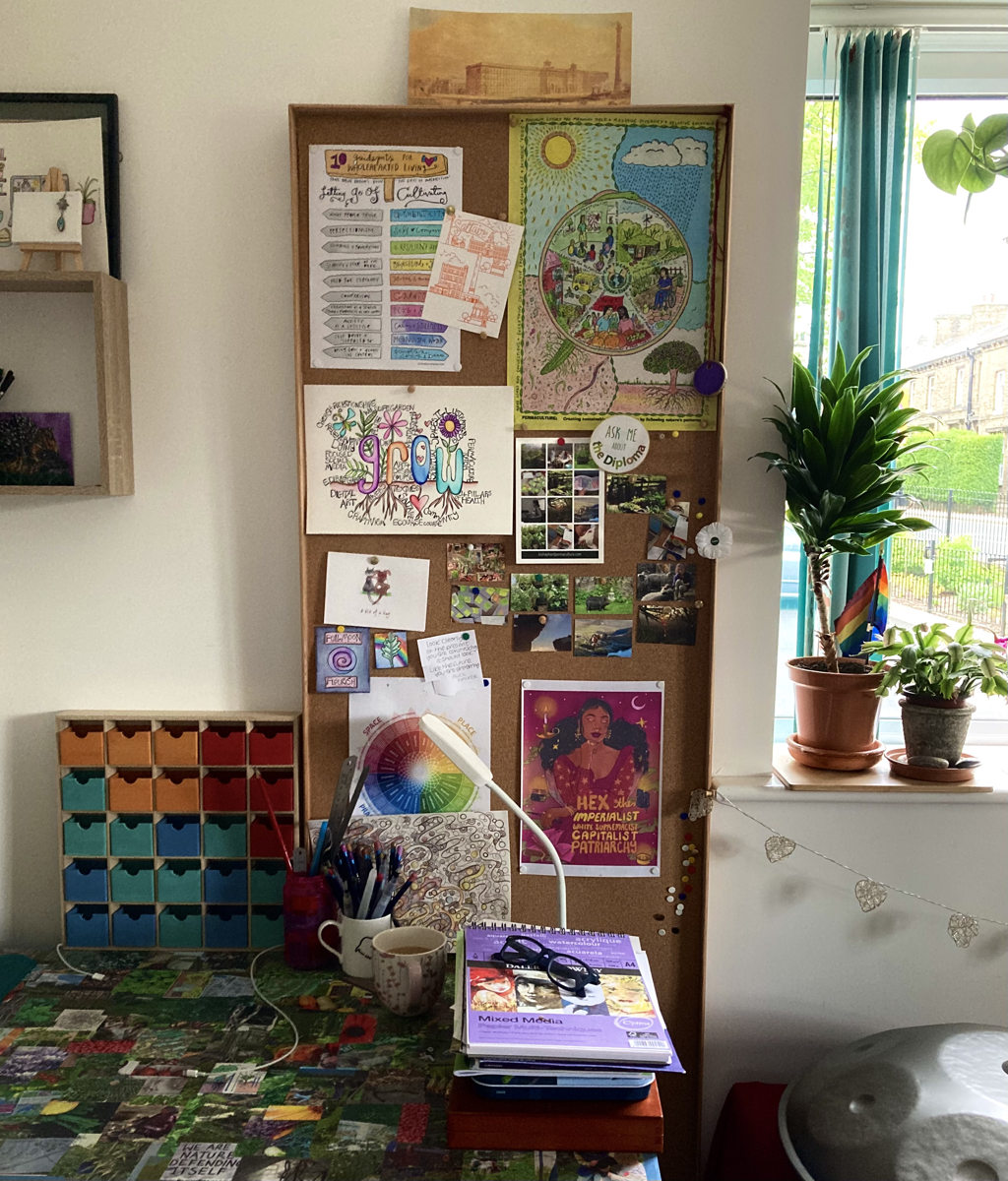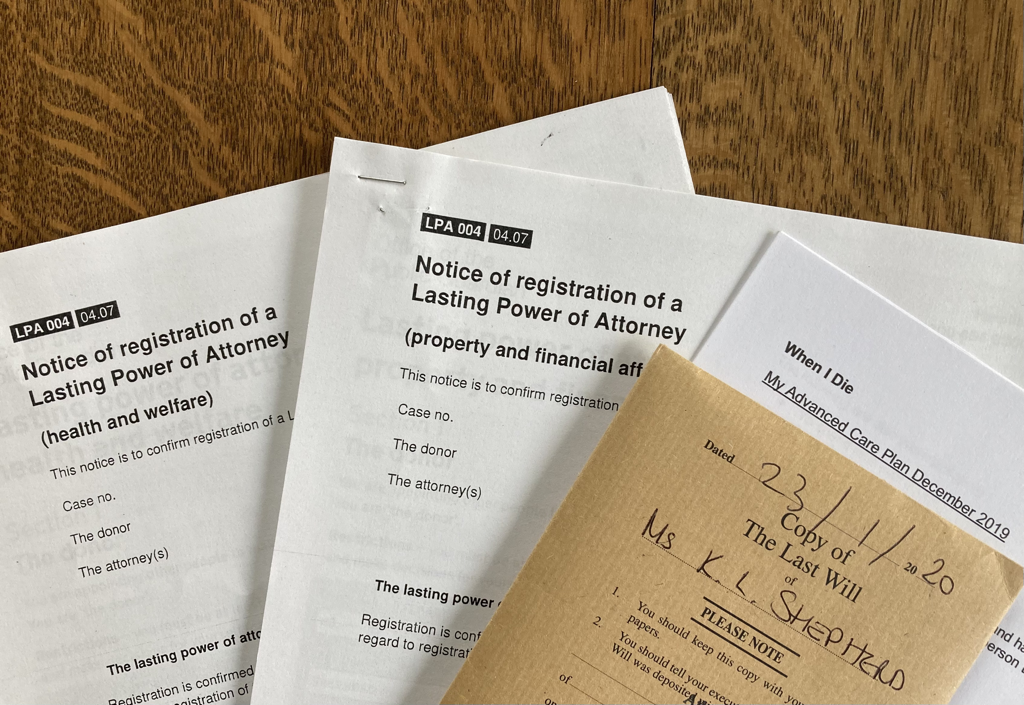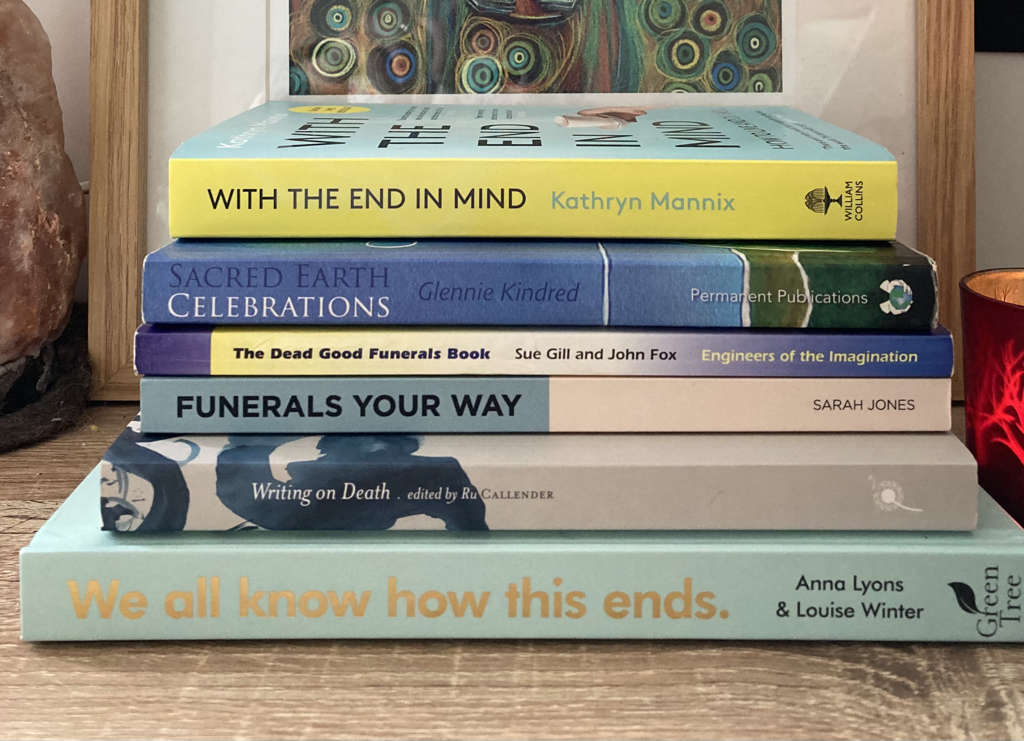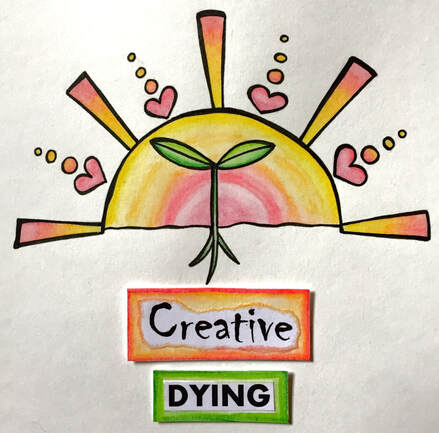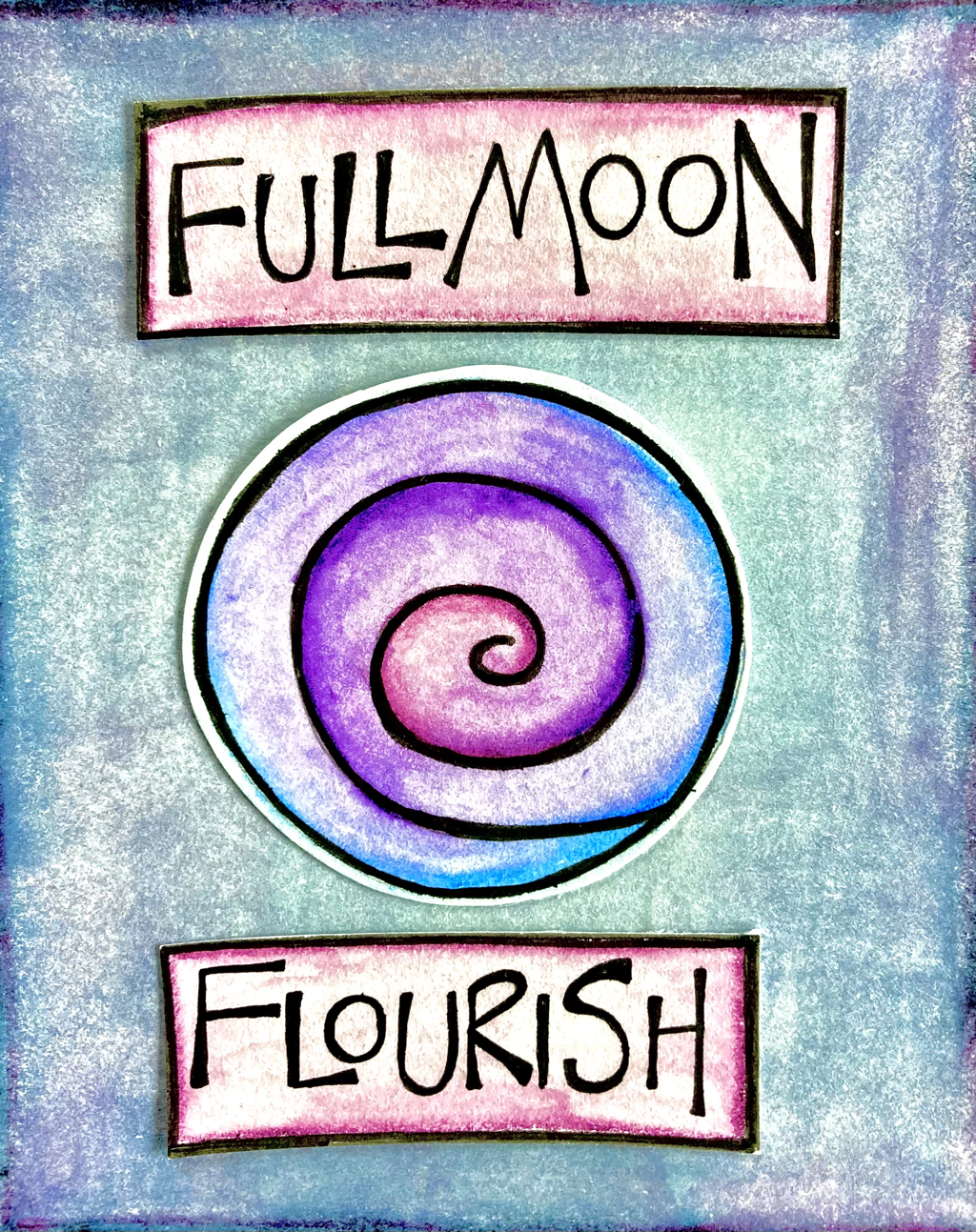|
Throughout 2024 I am starting to do more work around death, dying and grief again. This blog post contains some of the resources I refer to in the various events I am involved with.
Bradford Death Cafe Living With Death exhibition Leeds City Museum Creative Dying - My own advanced care plan “When I Die” a blog by me (includes lots more resources) A Lasting Legacy - how to have a more sustainable funeral Full Circle Funerals - great, progressive funeral directors in Yorkshire Poppy’s - great, progressive funeral directors in London Dying Matters - creating an open culture around death, dying and grief LGBTQ+ death, dying and bereavement resources PDF lgbtq_death_dying___bereavement_resources.pdf
0 Comments
I’m excited to be facilitating a series of 11 workshops throughout 2023, about how to use permaculture design in everyday life situations and events. The 2 hour monthly workshops are taking place at my brilliant neighbours, Salts Works in Saltaire, Bradford. Through relaxed information sharing, creativity and informal discussion, these workshops will enable participants to explore how permaculture can be used to navigate everyday life in ways that connect with our values. Each workshop focuses on a different topic and is created to be enjoyed as a stand alone event or as part of the year long series. Access Places are limited to 10 per booking. Salts Works is accessible for people using mobility aids, including wheelchairs. This includes an accessible toilet. There is also an accessible garden for anyone who needs a break from being indoors. COVID 19 Please feel free to wear a face covering/mask in the workshop, if this gives you the confidence to participate. People are asked not to attend if they have any symptoms of a new bug or virus. Cancellations for a full refund are available until 24 hours before the event. Also Each workshop costs £20. The price include hot/cold drinks, vegan & gluten-free sweet goodies and a takeaway mini zine about the main themes of the workshop. The Workshops - Details & BookingEveryday Permaculture - An Introduction
Saturday 18th February 10.00 - 12.00 Everyday Permaculture - Edible Gardening Saturday 18th March 10.00 - 12.00 Everyday Permaculture - Health & Wellbeing Saturday 15th April 10.00 - 12.00 Everyday Permaculture - Wildlife Spaces Saturday 20th May 10.00 - 12.00 Everyday Permaculture - Climate Actions Saturday 17th June 10.00 - 12.00 Everyday Permaculture - Designing Events Saturday 15th July 10.00 - 12.00 Everyday Permaculture - Right Livelihoods Saturday 19th August 10.00 - 12.00 Everyday Permaculture - Caring For Others Saturday 15th September 10.00 - 12.00 Everyday Permaculture - Death, Dying & Bereavement Saturday 21st October 10.00 - 12.00 Everyday Permaculture - Winter Festivals Planning Saturday 18th November 10.00 - 12.00 Everyday Permaculture - Designing 2024 Saturday 16th December 10.00 - 12.00 Please feel free to email me if you have any questions about these workshops Some ideas to support our grief and celebrations of Alan’s lifeSeveral of Alan’s friends are starting to plan an in-person event to gather and celebrate Alan’s life, probably in next Spring. I’ve created a list of ideas, incorporating different aspects of Alan’s life, to use as support for grief and celebration in the meantime. (The text and images from this blog post are also available as a printable PDF here ) Colouring in - colouring books/cards with coloured pencils or pens. If you are someone who has a stash of colouring in tools, maybe rearrange them by colour, as Alan did. Plant a tree, consider a fruit tree for added functions. Plant tree seeds in pots for planting into the ground in years to come. Support local creatives, by purchasing from them and/or sharing their work. Spend time with a tree or trees who hold significance for you, reflect on Alan’s life and the connections you had with him. Sing, dance, create, meditate, feast near trees. Write a letter to Alan. Compost, bury or burn it. Grow food or a tree in the soil where the compost, letter or ash has been placed. Start a practice of photographing patterns in nature, perhaps share these with friends either online or in person. Start supporting a local, small business, practicing ethics similar to your own. Visit a local independent café and eat cake. Consider starting a new daily spiritual practice. Bake bread. Create a nature altar, either outside or indoors, include space for a candle to burn in connection with Alan. Get involved with a local activism group creating regeneration for community and/or land. Consider starting a local activism group for regenerative change. Gather with others who know Alan, either in person or online. Share stories and memories of connection with Alan and his work. Consider mentoring someone who is wanting to develop skills similar to your own. Check in more frequently with friends who you know are struggling in some way. Prioritise your own self care. (We can best support others and participate in activism, if we place our own holistic wellness at the centre of our lives.) Practice self compassion on a regular basis. Remember that online activism is just as important as in person activism. Learn more about a particular tree. Its story, magic, science and significance. Mark and celebrate solar and lunar cycles & festivals. The above list is just some of my own ideas based on my experience of friendship with Alan. There might be some you don’t resonate with or agree with and that’s totally ok. Please feel free to create your own activities or adapt any of the above. Some further resources about griefGood-grief.org whatsyourgrief.com/resources/ cruse.org.uk Mind.org.uk Climate grief - some resources to help Some images about grief to print out and colour inCreative Dying - Resources and tools for designing our own death and dying is one of the designs in my portfolio for my Diploma in Applied Permaculture Design. I started this design in 2013 and it’s had several incremental changes over the years since. You can read more about Creative Dying and how permaculture can improve how we die, in a previous article I wrote here . The online resource I created then has now being archived and I’m currently in the process of designing the next steps of the project. Triggered by several major life changing events, including serious illness, I have recently been updating my When I Die plan, which was part of the initial Creative Dying design. I’ve not explicitly named the permaculture principles used throughout my plan, but see how many you can identify as you read through. Could the same principles help to shape your own Creative Dying related design? (The information shared in this blog relates to death, dying and bereavement in the UK) The functions of my When I Die planThe functions of my When I Die plan are
When I Die - Three SectionsMy When I Die plan consists of three sections
The Before I die and As I die sections of my plan contain personal information that isn’t appropriate to share in this blog, but the information can be categorised under the following headings -
Through both my work as a palliative care nurse and as a Carer for various family members, I am aware of some of the difficulties in meeting the wants and expectations of a person approaching the end of their life. These include -
Not being able to meet the exact expectations of a person who is dying can be a significant burden for friends and family which can in turn impact on their bereavement. So including various options in an advanced care plan can be really useful for everyone concerned. The third section of my When I Die plan, After I die, is typically the aspect of dying that most people planning for their death, focus on. It’s something which I am very happy to share the main elements here -
The final resting place for my bodyMy first choice for the placement of my body after my death, if available in the UK or other country where I die, is to be composted. Recompose are an amazing organisation founded by Katrina Spade, a permaculture designer and architect, in the US, who are pioneering the composting of human bodies. It’s a process that is already legal in several states and one if the aims of Recompose is to enable organisations in other countries to create similar systems. If human body composting is not not possible, including because of the wellbeing of people close to me, then I would like to be buried in a woodland burial site nearest to the address where I am living when I die. Ideally I would like to be buried in this blanket that I have made from felted knitted squares of natural coloured wool, (wool which is produced and sold directly from small farms in the UK). If burial in my blanket is not possible, including because of the wellbeing of people close to me, then I would like to be buried in the coffin I have already designed and purchased. This is in use as a book shelves and (the lid) as a notice board in my house. If I die outside the UK then I would like my body to be treated and placed as local custom, with my ideal choice always being burial. I would not want my body to be transported back to the UK. Celebration of life and saying goodbyeI have no fixed ideas or needs for those around me to celebrate my life and say goodbye after I die. Here is a list of some ideas I have that might assist people close to me involved in my after death care -
I have listed friends who are celebrants of various kinds and might be available to facilitate an event Legal aspects of my When I Die planA really important part of the update of my When I Die plan has been getting some of the legal aspects of the project completed. I got both Lasting Power of Attorney, Health and Welfare and Property and Financial Affairs, documents arranged, meaning that a close friend of mine can act on my behalf if I am too unwell to make decisions for myself and my own needs known. At the same time, with the same local solicitor, I wrote my Will which means that when I die my wishes for any belongings and/or financial assets that I own will be carried out. These documents took a bit longer to process than anticipated as they had just got into the legal system as the first lockdown for the COVID 19 pandemic commenced in the UK. However, they are complete now and the details in them will be honoured for the rest of my life. I can also change the content of any of these documents at any time, should I want too. A copy of my When I Die plan, while not legally binding, also sits with the Power Of Attorney documents and Will, both with my solicitor and in my paperwork at home. Two close friends have also got a copy of my When I Die document. Useful ResourcesThese books are some of my current favourite resources for making plans for dying. The following list is a selection of my current favourite online resources - Dying Matters Life. Death. Whatever The Digital Legacy Association The Good Grief Project End Of Life Care - LGBTQ Route To Success - Macmillan Cancer Support Anti-Racism: The Outer and Inner Work - End Of Life University Podcast How To Have An Environmentally Responsible Death - Marie Curie https://www.gov.uk/power-of-attorney A Greener Way To Go, What’s The Most Eco Friendly Way To Dispose Of A Body - The Guardian Eco Friendly Funerals - Green Eco Friend The Natural Death Centre FinallyWhether for your own death plan, or someone close to you, I hope its been useful to read about my own When I Die plan. I have other other new elements of Creative Dying planned over the next few months, sign up to my monthly newsletter to access them when available.
Using Permaculture to improve how we die I am a palliative care nurse and permaculture educator with a spiritual self which is deeply rooted in Earth-based seasons and patterns. Issues relating to death and dying are intrinsic to most aspects of my life. Several years ago, I started exploring how permaculture can improve how we die in the UK and in many parts of the world. Central to this was the fact that “Dying with dignity” appears in Holmgren’s Permaculture Flower, and generated many interesting discussions in my peer groups within the permaculture community. This eventually resulted in the launch of my permaculture project: Creative Dying, a free online resource.
Death and Dying in the UK In the UK and in many other parts of the world. Death and dying is still a very difficult, taboo topic, cloaked in the fear and unknown. The way in which many of us die at present in the UK is at odds with permaculture principles and ethics. People do not often get the death they would like, many needlessly dying in hospital experiencing unnecessary and distressing procedures, tests and treatment, away from their home, with resulting feelings of confusion and lack of control. Inequalities around whether a person is enabled to make decisions about what they would want for their end of life and care after death are huge – age, disease type, social class, sexuality, race, mental health, with very real consequences about whether someone then has a ‘good death.’ In my experience, fear, distress and lack of control about how we die can often mean life time effects on emotional and physical health to those left behind, due to complex bereavement. The environmental impacts of how we die are also very significant. – from the resources needed for end of life care in hospital, to the damaging actions of many aspects of the funeral/after death industry, - embalming, cremation, coffin materials - and financial affordability (the average cost of a funeral in the UK in 2018 was £3500 for a cremation, and nearly £4300 for a burial ) My experience in the permaculture community is that even within groups of people who are very knowledgeable, empowered and solutions focused about other aspects of their lives are reluctant to talk about how their end of life might be. So, what can permaculture offer as a way solutions focused way forward? Before We Die People who talk about and plan for their death, tend to have a much better experience of death, and those around them : - family, friends and community - then go on to have a more open and positive attitude towards death, loss and supporting others as they approach death. Planning for what we want to happen as we die and after our death is much easier to do when we are well, than waiting until we are unwell and perhaps too poorly to make decisions. There is a much greater chance that End of Life wants and wishes will happen if we have a plan, and others close to us, are aware of those plans. Ways to start talking about death and dying, and making plans include:-
As We Die If we had some control (most people, with the right support, do), what would we want our death to look like? Where would we want to be (if possible?) Who would we want to be there? What support would we need and want? One exciting and rapidly growing role is that of a Death Doula – non-medical people who are trained to be alongside terminally ill people and support those close to them, at the end of their life. There are several places in the UK where Death Doula training is available now and the numbers of people working in this sphere is spreading steadily. Obviously we cannot all predict how we die and for some we might not be able to achieve the ideal death we hoped for ourselves. It can be useful to have a ‘plan B’. For example, if you were to die in hospital, who would you want to be there? What kind of medical/nursing intervention would you want? What possessions, music, art would you want to surround you from home? After We Die What do we want to happen to our bodies after we die? How do we want our life to be remembered and celebrated? With our present systems of after death care in the UK, many people can feel frustrated, and let down, with their experience of grief deepened, as after death care activities carried out by health care professionals and then practitioners in the funeral industry can feel impersonal and profoundly disconnected from the identity of the person who has died. In addition, the financial cost of much of this is beyond the reach of an ever increasing number of people. There is no legal obligation to use a funeral director for after death care in the UK – though if you choose to do so, there are some wonderful Funeral Director and celebrant businesses who can ensure the whole process is as in keeping with the life of the person who has died as possible. In addition wherever we die, we can choose to have friends and families take care of us (wash, change clothing . Making this request known to health care staff involved can mean this is more likely to happen In the UK one of the most Earth regenerating ways to care for the body of someone who has died, is burial, where the body is wrapped/contained in a locally sources biodegradable material, in a geographical location where other life can benefit from the nutrients released by our decomposing corpse. (I’m currently knitting a cover from UK grown wool – which will be used a blanket, for hopefully many years, then my plan is my body will be wrapped in it before I am buried as close as possible to the place where I spend my final weeks of life.) Organised Woodland Burial sites are the most obvious choice of location., but there are other perfectly legal options. Globally there are some great projects emerging looking at ways of increasing Earth Care with relation to what happens to our bodies after we die. These include:- Recompose - transforms bodies into soil so that we can grow new life after we die. The Living Urn – growing trees from human ash Ecoffins - environmentally friendly coffins and caskets Conclusions Permaculture design offers us many answers to how we can improve an experience we all face, and which connects every living being and system on our beautiful planet. Opening up conversations, exploring fears, empowering ourselves with knowledge and support and then making documented plans are all very real ways of ensuring we work towards Earth Care, People Care and Fair Shares as we die. Resources In this article I have provided an overview about how permaculture design can help with way we die, which will hopefully engage a much bigger conversation. The following resources can help you to explore this topic further. As part of Creative Dying, my own project exploring how permaculture can improve how we die, I have a regularly updated page sharing many online, in real life and print resources. Go to Creative Dying for lots more information and ideas about using permaculture to improve how we die. Other (UK focused) favourite key online resources of mine are Natural Death Society Dying Matters Power of Attorney Compassionate Communities Soul Midwives For those people who use social media as a way of connecting and learning new knowledge, there is a wonderful diverse community of people globally working word to raise the profile of improving attitude and experience of death, dying and bereavement. The hashtag often used to link this work is #deathpositive. Finally – I would like to acknowledge the potential for triggering difficult feelings relating to loss and bereavement that people may experience through reading this article. These reactions are totally understandable and healthy. Many of us have experienced events where grief has been ongoing and complex. If this has happened for you then giving yourself to engage in activities which for you can provide the support you need is very much ok. If you find that you are needing something more than your usual emotional support tools then I can recommend the following links as first steps What’s Your Grief Cruse Bereavement Care An earlier version of this article "The Art of Dying Creatively" was also published in Permaculture Magazine (Autumn No 93) |
Welcome to my blog. Here I aim to share everyday examples of how permaculture can provide healing and regeneration for ourselves, our communities and our planet.
Search My BlogSign up for my monthly newsletter, Full Moon Flourish. Here I will be sharing updates about my creative permaculture projects, plus links to inspiring work from other women in permaculture.
Archives
May 2024
Categories
All
|
